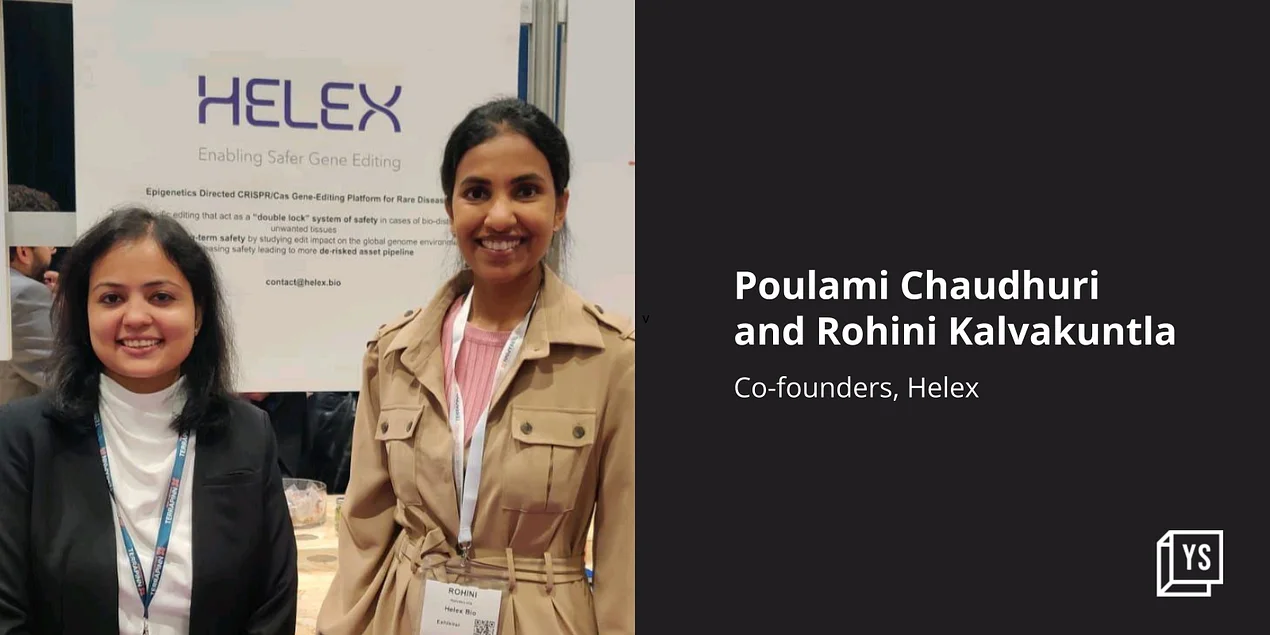UK becomes first to approve Casgevy genetic therapy for blood disorders
SOURCE: HTTPS://INTERESTINGENGINEERING.COM/
NOV 17, 2023
Biotech startup Helex brings precision to gene editing
SOURCE: YOURSTORY.COM
JUN 23, 2022

From Jurassic Park to Elysium, science fiction movies have used genetic engineering as a plot device to show the dark side of technology-led intervention in natural processes.
In the scientific community, however, genetic editing is looked upon as a potential way to eradicate diseases in plants and animals–including humans. CRISPR (Clustered Regularly Interspaced Short Palindromic Repeats) is one of the most widely-researched techniques to modify genes.
?Helex?, a New York-headquartered biotech startup founded in 2021 by Poulami Chaudhuri and Rohini Kalvakuntla, says it has developed a platform that acts as a GPS to improve the precision and safety of the gene editing done through CRISPR.
About 400 million people in the world suffer from rare disorders, with about 80 percent of these being of genetic origin. For example, Leber congenital amaurosis causes patients to be blind at birth.
Usually, these conditions are due to genetic mutations or errors. The ability to edit, remove or modify the defected portions in the genetic makeup of a person opens up the possibilities to cure these disorders. Genetic engineering can also be done via techniques such as Zinc-finger nucleases and Transcription activator-like effector nucleases (TALEN).
The first targeted genomic changes were produced in yeast and in mice in the 1970s and 1980s. However, the discovery of CRISPR-Cas9 genetic scissors, a sharper and economical gene-editing tool, in 2011 became a game-changer for the field of genetic engineering. Emmanuelle Charpentier and Jennifer Doudna were awarded a Nobel Prize for chemistry in 2020 for their work on CRISPR-Cas9.

Poulami Chaudhuri is the CEO and Rohini Kalvakuntla is the Chief Growth Officer of Helex
The discovery made it possible to modify DNA code over the course of a few weeks. The technique now finds application in several fields from agriculture to cancer research.
However, the scientific community is divided on CRISPR due to ethical and safety concerns, echoing the concerns of fiction writers. Gene editing, if not accurate, could have long-lasting damaging consequences on the human body.
CRISPR-Cas9 acts like a snipping tool, but for DNA in the cells.
Scientists can use genetic scissor protein–the Cas9 molecule–to snip a stretch of DNA to remove the affected part or modify it with a new one. This is done by clubbing the enzyme with a crucial element–guide RNA, an artificially created molecule that matches the code of DNA where the cut is to be made.
Get stories of change makers and innovators from the startup ecosystem in your inbox
The navigator or the guide RNA molecule, if not accurate, will lead the scissor protein to make a cut in the wrong place. This can have unintentional, harmful consequences on the tissues of the body.
“Safety: that is the biggest concern. That is the technology that we are working on with a vision to make genetic disease a thing of the past,” Rohini tells YourStory.
Helex has built a platform that acts as a GPS for genome editing. It makes the guide RNAs to be more gene, cell and tissue-specific.
A platform, in the biotechnology field, isn’t a software for users to interact or build applications on. “Platform is like processes you’ve developed,” Rohini explains.
Several permutations and combinations need to be tested to see what works for different tissues in the human body. This is done through in silico modelling–experimentation performed by computer and in vitro testing.
There are different requirements for different body parts that are attempted to be changed through CRISPR. “How you standardise the processes is the platform,” she adds.
Poulami, who has a Ph.D. in biochemistry and molecular biology from King’s College in London, explains how Helex brings precision to the gene-editing technique.
While we have the same DNA in the entire body, dominant genes (segments of DNA) are dependent on the body parts, for example, the eye or liver have different dominant genes.
“Each and every disease and gene that you work with is very custom-engineered that comes from the architecture of the cells, the architecture of the gene where it lies,” Poulami says.
Helex takes into account three-dimensional or four-dimensional factors such as primary or secondary structures of the tissue or DNA or its alignment, regulatory elements, says Rohini.
“These are very, very unique to the particular cell types as well as tissue types,” she adds.
This is a natural biological process, which is crucial in targeting a particular segment and not the entire body.
“We essentially identify some of these unique factors and design guide RNAs based on them, so that when the editing apparatus is unleashed, it recognises the elements only in the tissue of choice and makes edits there,” Rohini explains.
Rohini, with a decade-long experience in healthcare, has a double postgraduate degree in International Management from King’s College and Social Policy and Developmental Studies from the London School of Economics and Political Science. She and Poulami were flatmates when they studied in London.
“We play around with multiple parameters to come up with a perfect combination that would help achieve a good edit efficiency or a good ability to edit that particular gene and restrict it to the tissue of our choice,” Poulami adds.
The platform helps Helex's partners–drug developers–get favourable outcomes–precise DNA editing.
What that means is to study intended and also unintended genetic modifications and their impacts. It also helps them analyse the long-term clinical impacts.
The startup partners with organisations working in clinical trials to help them fast-track editing and improve safety profile and go to market faster. It usually works with them after the initial research and discovery phase, when they are trying to improve the safety and specificity of the trials.
In India, the startup has a lab in Hyderabad, where co-founder Poulami works.
Among other companies/institutions, Helex is working with LV Prasad Eye Institute and Dr Shroff Charity Eye Hospital to look for solutions for genetic disorders which lead to blindness.
The startup raised a $1.1 million round from IndieBio, which is an early-stage biotech programme by SOSV, a large biotech investment firm with over 1,000 portfolio companies and over $1 billion in AUM (assets under management).
“Manufacturing and being able to scale up these therapies is going to be huge in the future,” a spokesperson for SOSV said.
As an early-stage investor, SOSV is not necessarily looking at a five year-return on the investment, but a much longer time horizon of roughly about 10 years, the company says.
“We're looking at an idea and as a way to transform how folks are basically bringing therapies to market,” the spokesperson added.
The CRISPR based therapeutics market is expected to grow at an annualised rate of 129.2 percent to reach $2.2 billion by 2030, according to Roots Analysis, a biotechnology consulting firm.
Helex has a team of about 8-10 employees.
LATEST NEWS
Augmented Reality
Hi-tech smart glasses connecting rural and remote aged care residents to clinicians
NOV 20, 2023
WHAT'S TRENDING


Data Science
5 Imaginative Data Science Projects That Can Make Your Portfolio Stand Out
OCT 05, 2022

SOURCE: HTTPS://INTERESTINGENGINEERING.COM/
NOV 17, 2023
SOURCE: HTTPS://GENETICLITERACYPROJECT.ORG/
SEP 05, 2023
SOURCE: HTTPS://WWW.SCIENCEDAILY.COM/
AUG 07, 2023
SOURCE: HTTPS://WWW.SCIENCEDAILY.COM/
JUL 24, 2023
SOURCE: HTTPS://NEWS.MIT.EDU
JUL 20, 2023
SOURCE: BIOSPACE.COM
OCT 27, 2022